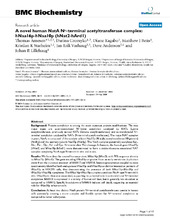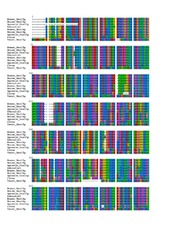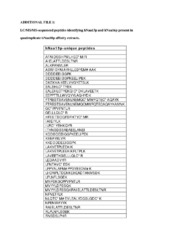| dc.contributor.author | Arnesen, Thomas | eng |
| dc.contributor.author | Gromyko, Darina | eng |
| dc.contributor.author | Kagabo, Diane | eng |
| dc.contributor.author | Betts, Matthew J. | eng |
| dc.contributor.author | Starheim, Kristian Kobbenes | eng |
| dc.contributor.author | Varhaug, Jan Erik | eng |
| dc.contributor.author | Anderson, Dave | eng |
| dc.contributor.author | Lillehaug, Johan | eng |
| dc.date.accessioned | 2013-10-09T08:25:06Z | |
| dc.date.available | 2013-10-09T08:25:06Z | |
| dc.date.issued | 2009-05-29 | eng |
| dc.Published | BMC Biochemistry 10(1):15 | eng |
| dc.identifier.issn | 1471-2091 | en_US |
| dc.identifier.uri | https://hdl.handle.net/1956/7375 | |
| dc.description.abstract | Background: Protein acetylation is among the most common protein modifications. The two major types are post-translational Nε-lysine acetylation catalyzed by KATs (Lysine acetyltransferases, previously named HATs (histone acetyltransferases) and co-translational Nα- terminal acetylation catalyzed by NATs (N-terminal acetyltransferases). The major NAT complex in yeast, NatA, is composed of the catalytic subunit Naa10p (N alpha acetyltransferase 10 protein) (Ard1p) and the auxiliary subunit Naa15p (Nat1p). The NatA complex potentially acetylates Ser-, Ala-, Thr-, Gly-, Val- and Cys- N-termini after Met-cleavage. In humans, the homologues hNaa15p (hNat1) and hNaa10p (hArd1) were demonstrated to form a stable ribosome associated NAT complex acetylating NatA type N-termini in vitro and in vivo. Results: We here describe a novel human protein, hNaa16p (hNat2), with 70% sequence identity to hNaa15p (hNat1). The gene encoding hNaa16p originates from an early vertebrate duplication event from the common ancestor of hNAA15 and hNAA16. Immunoprecipitation coupled to mass spectrometry identified both endogenous hNaa15p and hNaa16p as distinct interaction partners of hNaa10p in HEK293 cells, thus demonstrating the presence of both hNaa15p-hNaa10p and hNaa16p-hNaa10p complexes. The hNaa16p-hNaa10p complex acetylates NatA type N-termini in vitro. hNaa16p is ribosome associated, supporting its potential role in cotranslational Nα-terminal acetylation. hNAA16 is expressed in a variety of human cell lines, but is generally less abundant as compared to hNAA15. Specific knockdown of hNAA16 induces cell death, suggesting an essential role for hNaa16p in human cells. Conclusion: At least two distinct NatA protein Nα-terminal acetyltransferases coexist in human cells potentially creating a more complex and flexible system for Nα-terminal acetylation as compared to lower eukaryotes. | en_US |
| dc.language.iso | eng | eng |
| dc.publisher | BioMed Central | en_US |
| dc.rights | Attribution CC BY | eng |
| dc.rights.uri | http://creativecommons.org/licenses/by/2.0/ | eng |
| dc.title | A novel human NatA N-alpha-terminal acetyltransferase complex: hNaa16p-hNaa10p (hNat2-hArd1) | en_US |
| dc.type | Peer reviewed | |
| dc.type | Journal article | |
| dc.date.updated | 2013-08-28T16:45:51Z | |
| dc.description.version | Peer Reviewed | |
| dc.description.version | publishedVersion | en_US |
| dc.rights.holder | Thomas Arnesen et al.; licensee BioMed Central Ltd. | en_US |
| dc.rights.holder | Copyright 2009 Arnesen et al; licensee BioMed Central Ltd. | en_US |
| dc.identifier.doi | https://doi.org/10.1186/1471-2091-10-15 | |
| dc.identifier.cristin | 351477 | |
| dc.source.journal | BMC Biochemistry | |
| dc.source.40 | 10 | |
| dc.source.14 | 1 | |
| dc.source.pagenumber | 15- | |



